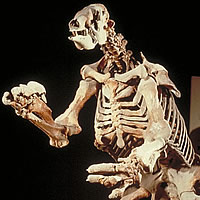It may be because I’m reading the new book on Resilience by Andrew Zolli and Ann Marie Healy. It may be because I taught two courses this past fall, one on each end of the scope and scale spectrum in the arts (one on cultural organizations, one on scrappy, start-up arts enterprises). Or it may just be that visiting any exhibit on evolution and change gets me thinking about the arts (occupational hazard).
But when I was wandering the Smithsonian National Museum of Natural History this weekend, the following plaque grabbed me and held my attention. It was discussing the historic fate of very large animals (giant sloths, woolly mammoths, and such). And here’s what it said:
Gigantism and Extinction
In a rapidly changing environment, large size may prove a disadvantage. A given area will not support as many large animals as small ones. Prolonged maturation of large animals slows the reproductive rate. Adaptation results from natural selection of the best adapted individuals over many generations. Consequently, quickly changing environments are more likely to affect seriously those animals with reduced ability to respond adaptively — those with small population numbers and slow reproductive rates.
I’ll leave you to connect the obvious dots between evolutionary gigantism and our current arts ecology (easy pickings). But the plaque made me wonder about the factors that made gigantism an advantage, exploited by many varieties of mammals for such a very long time. Compiled studies of fossil records suggest that lots of mammals got very, very large in the period following the dinosaur’s extinction, and their increasing size was an ideal way to fill available niches in the ecosystem…constrained only by temperature, land area, and available food. And even today, gigantism among lizards and other groovy animals is apparent on islands that lack predators and competition for resources.
As climates changed more quickly, and competition for resources grew more intense, the smaller animals gained the advantage…particularly because they could reproduce more frequently, and generate more options to adapt. Tough break, giant sloth.
I’m not suggesting that being large is a losing strategy, and being tiny is what’s next for the arts. I’m just suggesting that size is one of many variables that helps or hinders an enterprise, bringing a full spectrum of related benefits and constraints. Fortunately, organizations are not animals, and don’t have to wait an entire reproduction cycle (or 20) to generate adaptations. Organizations are collective decision systems. Their participants can decide to change at any time.
Of course, they can also decide not to.



Andrew, welcome to Washington or, as I think of it at times, the nation’s twilight zone of the arts. The Smithsonian is a wonderful place, no question – and a great source for metaphors. But I have a different suggestion for a place to visit. And a challenge for you. Try a day trip to visit the Workhouse in Lorton, VA. And as you read the links below & (I hope) visit the site, keep in mind that Fairfax County has the second highest median household income in the US & in my opinion virtually starved for arts & entertainment venues. (Full disclosure: I was on the board for a short time during the planning stages, but left quietly when it became clear that the intended business plan initially was to sell space to local (mostly amateur) artists & craftspeople — performing arts was entirely left out of the picture until “later.” But I still maintain that this place, with the right professional approach & support, is a potential gem waiting to be cut.)
Seriously, visit this place. (I’m posting this pubicly rather than emailing you because I know there are many others in the DC area who read your blog. The invitation/challenge goes to all.)
— Steve Soderberg
http://lorton.patch.com/articles/workhouse-arts-center-makes-cuts-looks-for-partnerships
http://potomaclocal.com/2012/06/12/lorton-workhouse-dissolves-performing-arts-center/#comments
http://www.washingtonpost.com/local/va-politics/red-ink-at-fairfax-countys-arts-center-in-lorton-forces-change/2012/06/19/gJQAzPD5oV_story.html
demographics:
http://en.wikipedia.org/wiki/Fairfax_County,_Virginia
Well are you trying to say that any thing huge will eventually break up or lose its existence as per gigantism. Any practical examples.